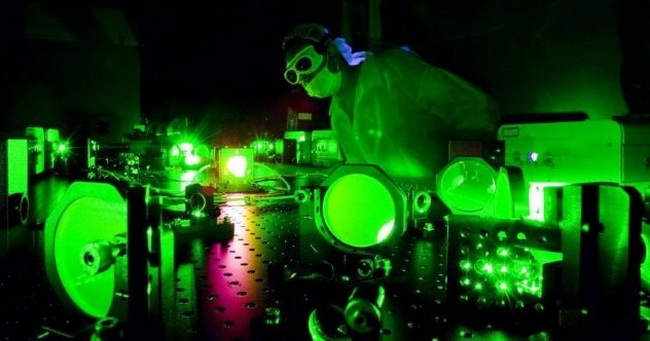In the wonderful world of physics, the impossible, though not immediately, but still becomes possible. And recently scientists have managed to achieve really super-impossible things. Science is progressing. Only one macaroni monster knows what else awaits us in its most secret depths. Today we will analyze the ten of unreal things, conditions and objects made possible by modern physics.
Incredibly low temperatures
In the past, scientists could not cool objects below the so-called “quantum limit” threshold. To cool something to this state, it is necessary to use a laser with very slowly moving atoms and to suppress the heat-generating vibrations created by them.
However, physicists have found the right solution. They created an ultra-small aluminum vibrating drum and were able to cool it down to 360 μKelvin, which is 10,000 times lower than the temperature in the very depths of outer space.
The diameter of the drum is only 20 micrometers (diameter of a human hair is 40-50 micrometers). It was possible to cool it to such ultra-low temperatures thanks to a new technology of so-called “compressed light”, in which all particles have one direction. Due to this, vibrations that generate heat are lost in the laser. Despite the fact that the drum is cooled to the lowest possible temperature, it is not the coldest kind of matter. This title belongs to the Bose-Einstein condensate. But even in this case, achievement plays an important role. Since once such a method and technologies can find their application for creating ultrafast electronics, and also help in understanding the strange behavior of materials of the quantum world, approaching in their properties to physical limits.
The brightest light
The light of the sun is dazzlingly bright. And now imagine the light of a billion Suns. It was he who was recently created by physicists in the laboratory, in fact creating the brightest artificial light on Earth, which also behaves in a very unpredictable manner. It changes the appearance of objects. However, human sight is not available, so it remains to believe physicists on the floor.
Molecular black hole
A group of physicists recently created something that behaves like a black hole. To do this, they took the world’s most powerful X-ray laser Linac Coherent Light Source (LCLS) and pushed it with the molecules of iodomethane and iodobenzene. Initially, it was expected that the laser pulse would knock most of the electrons from the orbit of the iodine atoms, leaving a vacuum instead. In experiments with weaker lasers, this void, as a rule, was immediately filled with electrons from the outermost boundaries of the orbit of the atom. When the LCLS laser hit, the expected process really started, but then a truly amazing phenomenon followed. Having received such a level of excitation, the iodine atom began to literally devour electrons from a number of hydrogen and carbon atoms. From the side it seemed like a tiny black hole inside the molecule.
Subsequent laser pulses knocked out the attracted electrons, but the vacuum tightened more and more. The cycle was repeated until the entire molecule exploded. Interestingly, the atom of the iodine molecule was the only one that shows similar behavior. Since it is on average more than others, it is able to absorb a huge amount of energy X-rays and lose their original electrons. This loss leaves an atom with a sufficiently strong positive charge, by which it attracts electrons from other, smaller atoms.
Metallic hydrogen
He was called the “sacred Grail of High Pressure Physics”, but until recently no one has succeeded in getting it. The possibility of converting hydrogen to metal was first voiced in 1935. Physicists of the time assumed that such a transformation can be caused by very strong pressure. The problem was that such pressure of technology of that time could not be created.
In 2017, the American team of physicists decided to return to the old idea, but used a different approach. The experiment was carried out inside a special device, called a diamond vise. The pressure created by these clamps is produced by two synthetic diamonds located on both sides of the press. Thanks to this device it was possible to achieve an incredible pressure: more than 71.7 million pounds per square inch. Even in the center of the Earth, the pressure is lower.
Computer chip with brain cells
If you breathe life into electronics, then the light one day can replace electricity. Physicists understood the amazing potential of light decades ago, when it became clear that light waves can move parallel to each other and thus perform many simultaneous tasks. Our electronics rely on transistors that open and close the way for electricity. This scheme imposes many limitations. However, recently scientists have created an amazing invention – a computer chip that mimics the work of the human brain. Through the use of interacting rays of light, working as neurons in the living brain, this chip is able to really “think” very quickly.
Previously, scientists could also create simple artificial neural networks, but this equipment was occupied by several laboratory tables. Create something that has the same efficiency, but is much smaller, was considered impossible. And yet it succeeded. The chip size, based on silicon, is only a few millimeters. And he conducts computational operations with the help of 16 integrated neurons. It happens this way. The chip is fed with laser light, which is divided into several beams, each of which contains a signal number or information varying in brightness level. The output intensity of the lasers responds to a numerical task or any information for which a solution was required.
Impossible form of matter
There is a type of matter called the “superfluid solid”. And in fact, this matter is not as terrible as it might seem from the title. The fact is that this very bizarre form of matter has a crystalline structure characteristic of solids, but at the same time is a liquid. This paradox remained unrealized for a long time. However, in 2016 two independent groups of scientists (American and Swiss) created matter, which can rightfully be attributed to the properties of a superfluid solid. Interestingly, both teams used different approaches to creating it.
The Swiss created the condensate Bose-Einstein (the coldest of known substances), cooling to extremely low temperatures the rubidium gas. Then the condensate was placed in a two-chamber unit, in each chamber of which there were installed small mirrors facing each other. Laser beams were sent to the cameras, which triggered the transformation. The gas particles in response to the laser action have built up the crystalline structure of the solid, but in general the matter has retained its fluidity.
Americans received a similar hybrid matter based on condensate from sodium atoms, which were also strongly cooled and exposed to a laser. The latter were used to shift the density of atoms before the appearance of the crystal structure in a liquid form.
Liquid with a negative mass
In 2017, physicists created a really cool thing: a new form of matter that moves toward a force that repels it. Although this is not quite a boomerang, but this matter has something that can be called a negative mass. With a positive mass, everything is clear: you give acceleration to an object, and it starts moving in the direction in which this acceleration was transferred. However, scientists have created a fluid that works quite differently from anything in the physical world. When it is pushed, it is accelerated to the source of the accelerated acceleration.
And again the Bose-Einstein condensate came to the aid in this matter, in the role of which the atoms of rubidium, cooled to ultralow temperatures, appeared. Thus, scientists have obtained a superfluid liquid with a common mass. Then they strongly squeezed atoms with the help of lasers. Then, with a second set of lasers, they strongly excited the atoms, so much so that they changed their backs. When the atoms were freed from the laser clutches, the reaction of the ordinary fluid would be the movement from the fixation center, which in fact can be interpreted as pushing. However, the superfluid liquid from rubidium, whose atoms were given sufficient acceleration, remained in its place when released from the laser vice, thereby demonstrating a negative mass.
Time Crystals
When Frank Wilczek, Nobel laureate, first proposed the idea of time crystals, she seemed insane. Especially in the part in which it was explained that these crystals can have movement, while remaining at rest, that is, demonstrating the lowest level of energy of matter. This seemed impossible, since energy requires energy for motion, and the theory in turn says that there is practically no energy in such crystals. Wilczek believed that perpetual motion can be achieved by changing the ground state of the crystal atom from stationary to periodic. This went against the laws of physics known to us, but in 2017, five years after Wilczek proposed it, physicists found a way to do it. As a result, at Harvard University created a time crystal, where nitrogen impurities “rotated” in diamonds.
Bragg Mirrors
The Bragg mirror is not highly reflective and consists of 1000-2000 atoms. But it can reflect light, which makes it useful wherever it is necessary to use tiny mirrors, for example, in advanced electronics. The shape of such a mirror is also not entirely ordinary. Its atoms are suspended in a vacuum and resemble a chain of beads. In 2011, a German team of scientists was able to create the Bragg mirror, which at that time had the highest level of reflection (about 80 percent). To do this, scientists combined 10 million atoms in one lattice structure.
However, later scientific teams from Denmark and France found a way to substantially reduce the number of necessary atoms, but at the same time to maintain high reflective efficiency. Instead of densely joining each other, the atoms were placed along a microscopic optical fiber. With the correct arrangement, the necessary conditions arise – the light wave is reflected straight back to the point of its origin. When light is transmitted, some photons break out of the fiber and collide with atoms. The reflective efficiency demonstrated by the Danish and French teams is very different and amounts to about 10 and 75 percent respectively. However, in both cases, the light returns (that is, reflects) to the point of its origin.
In addition to promising advantages in the development of technologies, such mirrors can be useful in quantum devices, since atoms additionally use a light field to interact with each other.
Two-dimensional magnet
Physicists have tried to create a two-dimensional magnet since the 1970s, but have always failed. A real 2D magnet must retain its magnetic properties, even if divided to a state where it becomes a two-dimensional, or a layer that is only one atom thick. Scientists even began to doubt that such a thing is possible at all.
However, in June 2017, physicists, using chromium triiodide, finally managed to create a two-dimensional magnet. The connection was very interesting right from several sides. Its layered crystal structure is excellent for narrowing, and, in addition, its electrons have the necessary spin direction. These important properties allow the chromium triiodide to retain its magnetic properties even after its crystalline structure is reduced to the thickness of the last atomic layers.
The world’s first 2D magnet was able to be obtained at a relatively high temperature of -228 degrees Celsius. Its magnetic properties cease to operate at room temperature, since it is destroyed by oxygen. However, experiments continue.





















